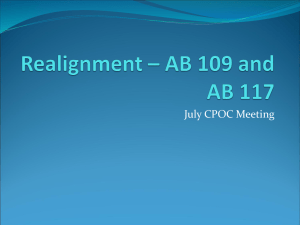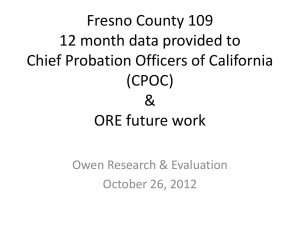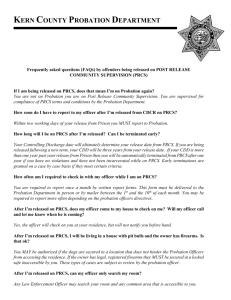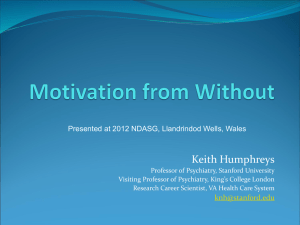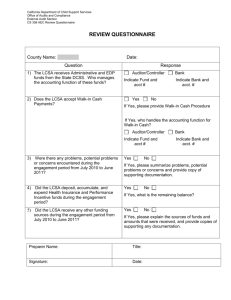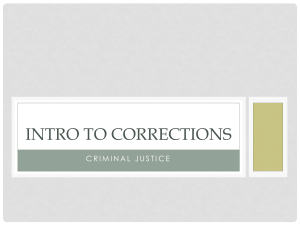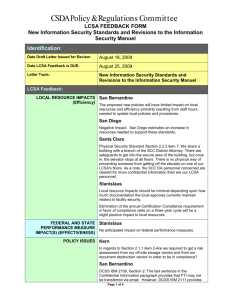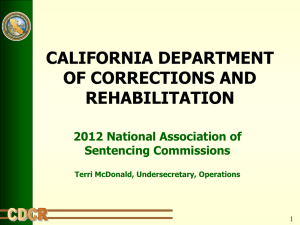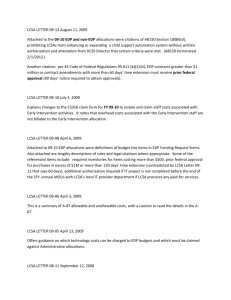W-35-AB109-What-Does.. - CHILD SUPPORT DIRECTORS
advertisement
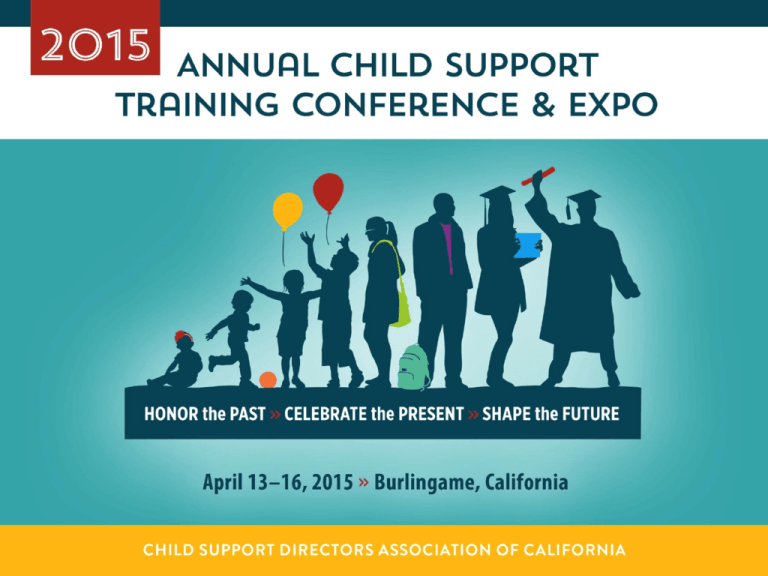
AB 109- What does Realignment Look Like for Child Support? Zahira Jiminez CSO II Yolo County LCSA Rebecca M. Durney Assistant Director/Chief Attorney Siskiyou-Modoc Regional LCSA History of AB 109 In the case of Brown v. Plata (2010) 131 S.Ct. 1910, 1928, 1947, the United States Supreme Court held that California must reduce its prison population to 137.5 percent of design capacity within two years. That ruling mandated drastic changes to the overcrowded California prison system. California responded by passing Assembly Bill 109 and AB 117, a sweeping overhaul of the state’s correctional system. History of AB 109 AB 109 was approved by Governor Jerry Brown on April 4, 2011 and effective October 1, 2011. Since then, trailer legislation has guaranteed sufficient funding streams for counties to implement realignment. $400 million was allocated to counties in the first partial fiscal year. More than $1 billion was allocated in the 13-14 fiscal year. AB 109 Changes AB 109’s major changes include: keeps non-violent, non-serious, nonsex offenders (“non-non-nons” or “3 nons”) in county jail rather than state prison; places non-violent, non-serious offenders under county-level supervision after release; AB 109 Changes limits parole revocation time for these offenders to a maximum of 180 days and houses parole violators in county jail; and provides counties with secure funding to implement these changes based on the rates they previously sent inmates to be incarcerated in state prison. Penal Code § 3451 Section 3451 of the Penal Code as amended by A.B. 109, now directs that non-serious, nonviolent, nonsex offenders (“3-nons”): ✷ “shall, upon release from prison and for a period not exceeding three years immediately following release, be subject to community supervision provided by a county agency . . . which is consistent with evidence-based practices.” Community Corrections Partnership Under California Penal Code § 1230(b)(2), every county is mandated to have a high level Community Corrections Partnership (“CCP”) to oversee implementation of it’s realignment plan. The CCP in turn relies on the county’s Post Release Community Supervision (PRCS) program, which is the day-to-day, hands-on group that really works with this population and provides the required supervision. CCP Statutory Members The Executive Committee for every county CCP must include as members: Chief Probation Officer Chief of Police Sheriff DA PD Presiding Judge or designee Representatives from Social Services, Mental Health, Alcohol and Drug Services as appointed by the County Board of Supervisors More of a “Steering Committee.” Post Release Community Service Members The PRCS program brings to the table anyone who might provide mutual beneficial assistance to the successful supervision of local offenders: Probation officers Local police & Sheriff Mental & Behavioral Health reps Alcohol, drug and substance abuse reps DCSS, Human Services, Health Dept. EDD and job placement reps Faith based organization reps Jail personnel Local Community Center reps Other Community Based Organization reps How important is Realignment? Prior to Realignment: Over 60,000 felony parole violators returned to state prison annually Their average stay was 90 days As of 09/30/2011, the felony parole violator population was 13,285 inmates All parole revocations were heard by the Parole Board and violators were housed in state prison Impacts of Realignment Since Realignment: As of November 30, 2013, the felony parole violator state prison population was 25, down from 13,285 Annual admissions of newly convicted offenders from county courts to state prison have gone from 55,000-65,000 down to less than 36,000 a year Overall, the diversion of both offenders and parole violators to county jail instead of state prison resulted in a population decrease of about 25,000 All parole revocations are now served in county jail and cannot exceed 180 days. Impact of Realignment on LCSA Changes internally: Did 109 alternate sentencing change how you calculate guideline child support? “Low level” offenders no longer incarcerated but put on work crews, wear monitoring gear, ordered to mandatory counseling and classes Do you impute lower income? Do you use zero income? Do you coordinate with the DA, Public Defender or Probation? Is this a significant change of circumstance to warrant modification? Did you adjust or stay your arrears liquidation? Do you share your local information with any other counties who have obligor’s in your county? Impacts of Realignment on LCSA “There’s no room at the Inn” Impact on Special Enforcement- Resources Contempt- No jail cells nor work crew space Criminal Referrals- Lowest rung of criminal justice system priorities and jail space Alternate Sentencing- county by county availability of where/ what to sentence The PRCS Program Table Is DCSS at the PRCS Table? Probation is the designated responsible agency for PRCS in all 58 counties PRCS coordinates a collaborative group to provide one stop services for program participants DCSS should reach out and be at the table LCSAs should facilitate communication with other county LCSAs and be the liaison for child support issues The relationships may be informal or formal, thru an MOU between agencies Break down those Silos!!! PRCS Realignment Plans PRCS Objective is to Reduce: Overcrowding Costs Recidivism PRCS Plans may include: day reporting centers drug court residential multiservice centers mental health treatment programs electronic and GPS monitoring programs victim restitution programs counseling programs Community service programs educational programs and work training programs At the PRCS Table Siskiyou LCSA is part of their county PRCS collaborative agencies. Regular meetings set by Probation Provided list of offenders currently under supervision and their status (warrant, awol, new offense, participating as ordered, inside view) Probation invites relevant guest speakers and services that may benefit other agencies General review of facts and situations to better coordinate services, assign contacts, liaisons Allows LCSA to process cases with better understanding of case situations. Establishes points of contact to provide services. 2014: Prop 47 On November 4, 2014, the California voter voted in a controversial “Safe Neighborhoods and Schools Act” that became effective November 5, 2014. A number of former felonies are now reduced to misdemeanors. A number of “former” felons had their crimes reclassified and were released en masse from prisons and jails statewide. Some convicted felons can now petition to have their cases reduced to misdemeanors and corresponding earlier release dates. Prop 47 Specifics Many crimes that were previously “arrestable” as a felony are now only “citable” as a misdemeanor. That means they are not booked into jail but rather given a citation (similar to a traffic ticket) with a court date to appear, and released in the field. They are NOT held pending trial. Felony crimes that are now misdemeanors include: Commercial burglary (theft under $950) Forgery and bad checks (under $950 value) Theft of most firearms Theft of a vehicle (under $950 value) Possession of stolen property (under $950 value) Possession of heroin, cocaine, illegal prescriptions, concentrated cannabis, and methamphetamine Prop 47 and Child Support • Similar to the impacts of AB 109 and the immediate or early release of offenders, it may direct some action by your LCSA. • • Review for modification? Adjust case closures considerations? • As a misdo, will they serve any time or fall to the bottom of sentencing heap because local beds are filled with AB 109 felon offenders? • Do they have alternate sentencing that prevents them from seeking work or working, or that includes seek work provisions? • Further impact on Special EnforcementContempt and Criminal even available? Yolo LCSA and PRCS Purpose: To provide efficient child support and probation services to shared participants, engaging the parent in the need to financially support their children and assisting the offender with successful reentry into the community Yolo LCSA and PRCS Data Research • $4.3 million in past due child support • $16,865 owed collectively in monthly current child support • 68% had not made a payment on their child support arrears in the 2014 Federal Fiscal Year • • • 154 child support cases with high risk offenders 52 child support cases with moderate risk offenders 37 child support cases with low risk offenders Yolo LCSA and PRCS Program Collaborative Goals • Collect $75,000 in current and past due child support(August 2014-June 2015) • 66% of the program participants make at least one payment within the year on their child support arrears • 40% of participants with current support owing start making payments on their support obligation within the project period Yolo LCSA and PRCS Statistical Outcome To Date • Number of participants on the list: 136 participants/192 cases • Number of participants contacted by DCSS/Probation 88(Approx 62% contact rate) • Number of participants who made a payment on a current support: 42 owe current support/18 or 43% have made a payment • Number of participants who made at least one payment 82 participants/226 payments(93% payment rate of those contacted) Yolo LCSA and PRCS Monthly Collections • • • • • • • August 2014 September 2014 October 2014 November 2014 December 2014 January 2015 February 2015 • Total $9,173.20 $7,393.90 $6,245.80 $8,620.25 $7,423.05 $6,969.27 $16,049.13 _____________ $61,874.60 Yolo LCSA and PRCS • • • • The Yolo Day Reporting Center Treatment Education Job Readiness Life Skills • Funded by AB109 and Department of Corrections • Served over 700 clients(in custody/ out of custody) since they opened in 03/2013 Best Practices Tear down your LCSA “Cone of Silence” and collaborate with your other county agencies and CBO’s to provide better customer service Negotiate an MOU with your Probation department to share information and help with the child support program processes statewide Bring this up with your local court at your 1058 meetings to coordinate understanding Examine your local practices regarding guideline child support, special enforcement, closure Zahira Jimenez Email: Zahira.Jimenez@yolocounty.org Phone: 530-661-2862 Rebecca M Durney Email: rdurney@co.siskiyou.ca.us Phone: 530-841-2991
